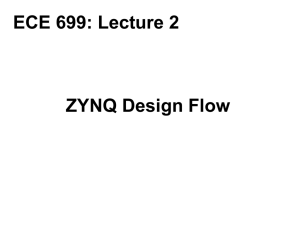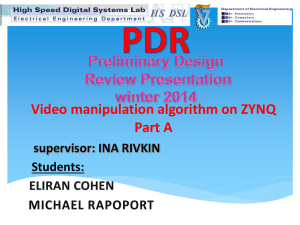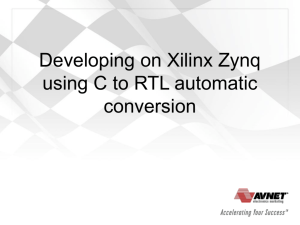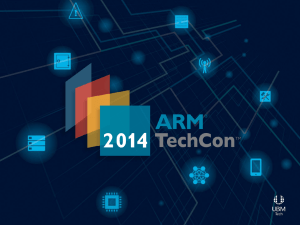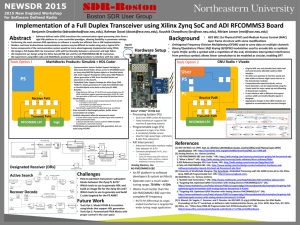ppt - the GMU ECE Department
advertisement
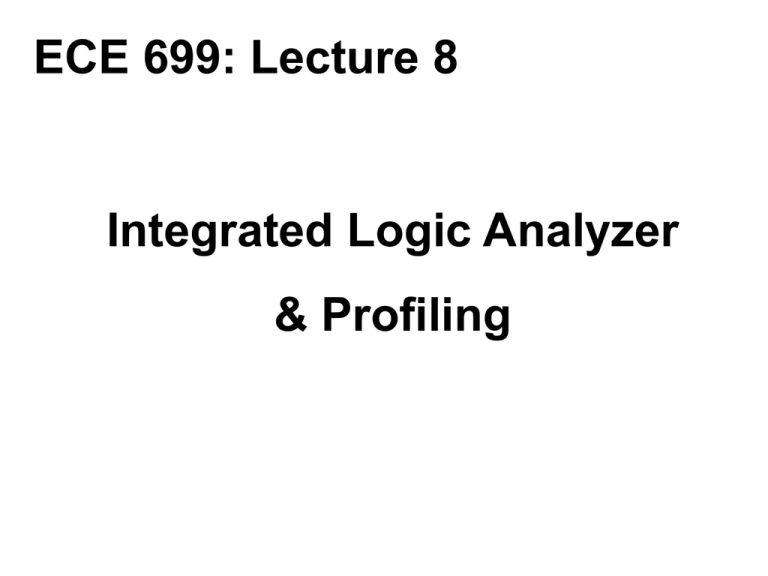
ECE 699: Lecture 8
Integrated Logic Analyzer
& Profiling
Required Reading
LogiCORE Intergrated Logic Analyzer v5.0, PG172
LogiCORE IP Virtual Input/Output v3.0, PG159
Vivado Design Suite User Guide, Programming and
Debugging, UG908
•
•
Chapter 5: Debugging Logic Design in Hardware
Chapter 6: Viewing ILA Probe Data in the Waveform
Viewer
Xilinx Advanced Embedded System Design on Zynq
•
Lab 2: Debugging Using Hardware Analyzer (on Piazza)
Recommended Videos
Xilinx Inc., Programming and Debugging Design
in Hardware
https://www.youtube.com/watch?v=i8axs4hw2f4
M.S. Sadri, ZYNQ Training
(presentations and videos)
•
Lesson 12 – AXI Memory Mapped Interfaces
and Hardware Debugging, Part 1
Required Reading
The ZYNQ Book
•
•
Chapter 4.3.2 Execution Profiling
Chapter 11.2 Profiling
EDK Profiling User Guide, A Guide to Profiling in
EDK, UG448
GNU gprof
https://sourceware.org/binutils/docs/gprof/index.html
Xilinx Advanced Embedded System Design on Zynq
•
•
Profiling and Performance Improvement (on Piazza)
Lab 6: Profiling and Performance Tuning (on Piazza)
Traditional Logic Analyzer
Source: Agilent Technologies
Traditional Logic Analyzer
Source: Agilent Technologies
Traditional Logic Analyzer
Source: technology guerilla
Traditional Logic Analyzer (1)
•
•
•
•
An electronic instrument that captures and displays multiple
signals from a digital system
Can be triggered on a complicated sequence of digital events,
then capture a large amount of digital data from the
system under test (SUT)
Once the probes are connected, the user programs
the analyzer with the names of each signal, and can group
several signals together for easier manipulation
A capture mode is chosen, either "timing" mode, where
the input signals are sampled at regular intervals based on
an internal or external clock source, or "state" mode, where
one or more of the signals are defined as "clocks", and data
are taken on the rising or falling edges of these clocks
Source: Wikipedia
Traditional Logic Analyzer (1)
•
•
•
A trigger condition is set. It can range from simple (such as
triggering on a rising or falling edge of a single signal)
to very complex
The user sets the analyzer to "run" mode, either triggering
once, or repeatedly triggering
Once the data are captured, they can be displayed several
ways, from the simple (showing waveforms or state listings)
to the complex (showing decoded Ethernet protocol traffic)
Source: Wikipedia
Traditional Logic Analyzers
Useless for Systems-on-Chip (SoC)
Source: The Zynq Book
Integrated Logic Analyzer
Source: Integrated Logic Analyzer v5.0, LogiCORE IP Product Guide
Integrated Logic Analyzer
•
•
•
•
•
•
•
IP core
The core parameters specify the number of probes, the width
for each probe input, and the trace sample depth
After the design is loaded into the FPGA, one uses
the Vivado® logic analyzer software to set up a trigger event
for the ILA measurement
After the trigger occurs, the sample buffer is filled and
uploaded into the Vivado logic analyzer
Signals, attached to the probe inputs, are sampled at
design speeds and stored using on-chip block RAM (BRAM)
Communication with the ILA core is conducted using
an auto-instantiated debug core hub that connects to
the JTAG interface of the FPGA
The user can view this data using the waveform window
Source: Integrated Logic Analyzer v5.0, LogiCORE IP Product Guide
ILA Setup – Native Mode
Source: Integrated Logic Analyzer v5.0, LogiCORE IP Product Guide
ILA Setup – Native Mode
Source: Integrated Logic Analyzer v5.0, LogiCORE IP Product Guide
ILA Setup – AXI Mode
Source: Integrated Logic Analyzer v5.0, LogiCORE IP Product Guide
ILA Setup – AXI Mode
Source: Integrated Logic Analyzer v5.0, LogiCORE IP Product Guide
ILA Dashboard
Source: Vivado Design Suite User Guide, Programming and Debugging
ILA Trigger Modes
•
•
•
•
•
BASIC_ONLY: the AND or OR of logic values
obtained by applying (possibly sophisticated) comparisons
to selected probe values
ADVANCED_ONLY: internal trigger signal specified by a user
defined state machine.
TRIG_IN_ONLY: the rising edge of the TRIG_IN pin
of the ILA core
BASIC_OR_TRIG_IN: combination of BASIC_ONLY
and TRIGGER_IN_ONLY
ADVANCED_OR_TRIG_IN: combination of ADVANCED_ONLY
and TRIGGER_IN_ONLY
Source: Vivado Design Suite User Guide, Programming and Debugging
ILA Basic Trigger Setup
Source: Vivado Design Suite User Guide, Programming and Debugging
ILA Basic Trigger Setup
Operators: ==, !=, <, <=, >, >=
Radix: [B] Binary, [H] Hexadecimal, [O] Octal, [A] ASCII,
[U] Unsigned Decimal, [S] Signed Decimal
Value:
[B] Binary: 0, 1, X (don’t care), R (rising edge), F (falling edge),
B (either edge), N (no transition)
[H] Hexadecimal: 0-9, A-F, X (don’t care for all 4 bits)
[O] Octal: 0-7, X (don’t care for all 3 bits)
[A] ASCII: any ASCII string
[U] Unsigned Decimal: Any non-negative integer value
[S] Signed Decimal: Any integer value
Source: Vivado Design Suite User Guide, Programming and Debugging
Setting Basic Trigger Condition
Source: Vivado Design Suite User Guide, Programming and Debugging
ILA Dashboard
Source: Vivado Design Suite User Guide, Programming and Debugging
Trigger Out Modes
•
DISABLED: disables the TRIG_OUT port
•
TRIGGER_ONLY: enables the result of the basic/advanced
trigger condition to propagate to the TRIG_OUT port
•
TRIG_IN_ONLY: propagates the TRIG_IN port to the
TRIG_OUT port
•
TRIGGER_OR_TRIG_IN: enables the result of a logical
OR-ing of the basic/advanced trigger condition and
TRIG_IN port to propagate to the TRIG_OUT port
Source: Vivado Design Suite User Guide, Programming and Debugging
Capture Mode Setting
•
The ILA core can capture data samples when the core
status is Pre-Trigger, Waiting for Trigger, or Post-Trigger
•
The Capture mode control is used to select what condition is
evaluated before each sample is captured:
•
•
ALWAYS: store a data sample during a given clock cycle
regardless of any capture conditions
•
BASIC: store a data sample during a given clock cycle
only if the capture condition evaluates "true”
The BASIC capture mode used to describe a capture condition
that is a global Boolean equation of participating debug
probe comparators
Source: Vivado Design Suite User Guide, Programming and Debugging
Class Exercise 1
Block Diagram
Source: Xilinx Advanced Embedded System Design on Zynq course materials
Class Exercise 1
Block Design
Source: Xilinx Advanced Embedded System Design on Zynq course materials
Class Exercise 1
Setting up the trigger
Source: Xilinx Advanced Embedded System Design on Zynq course materials
Class Exercise 1
Mark Debug
Source: Xilinx Advanced Embedded System Design on Zynq course materials
Class Exercise 1
Setting up the Corresponding ILA
Source: Xilinx Advanced Embedded System Design on Zynq course materials
Class Exercise 1
Monitoring AXI Transactions
Source: Xilinx Advanced Embedded System Design on Zynq course materials
Class Exercise 1
Block Design
Source: Xilinx Advanced Embedded System Design on Zynq course materials
Class Exercise 1
Math IP
Source: Xilinx Advanced Embedded System Design on Zynq course materials
Virtual Input Output
Source: LogiCORE IP Virtual Input/Output
VIO Probes
Source: Xilinx Advanced Embedded System Design on Zynq course materials
Profiling
Processor Activity Before and After
Hardware Acceleration
Source: The Zynq Book
Types of Profiling
Static
• Without executing software program
• Analysis of source code or object code
Dynamic
• Intrusive process whereby whereby the execution of
a program on a processor is interrupted to gather
information
Source: The Zynq Book
Dynamic Profiling
Source: The Zynq Book
Output of Dynamic Profiling
Source: The Zynq Book
Class Exercise 2
Block Diagram
Source: Xilinx Advanced Embedded System Design on Zynq course materials
Class Exercise 2
Block Design
Source: Xilinx Advanced Embedded System Design on Zynq course materials
Class Exercise 2
SDK Settings
Source: Xilinx Advanced Embedded System Design on Zynq course materials
Class Exercise 2
Main.c: Choice between Two Implementations
int main(void)
{
short signal, output;
int i;
for (i=0; i<SAMPLES; i++) {
if(i==0)
signal = 0x8000;
else
signal = 0;
#ifdef SW_PROFILE
fir_software(&output, signal);
#else
filter_hw_accel_input(&output, signal);
#endif
}
return 0;
}
Source: Xilinx Advanced Embedded System Design on Zynq course materials
Class Exercise 2
fir_software()
#include "fir.h”
void fir_software (data_t *y, data_t x)
{
const coef_t c[N+1]={
#include "fir_coef.dat”
};
static data_t shift_reg[N];
acc_t acc;
int i;
Source: Xilinx Advanced Embedded System Design on Zynq course materials
Class Exercise 2
fir_software() – cont.
acc=(acc_t)shift_reg[N-1]*(acc_t)c[N];
loop: for (i=N-1;i>=0;i--) {
acc+=(acc_t)shift_reg[i-1]*(acc_t)c[i];
shift_reg[i]=shift_reg[i-1];
}
acc+=(acc_t)x*(acc_t)c[0];
shift_reg[0]=x;
*y = acc>>15;
}
Source: Xilinx Advanced Embedded System Design on Zynq course materials
Class Exercise 2
filter_hw_accel_input()
void filter_hw_accel_input(short * Sample_L_out, short Sample_L_in)
{
Xil_Out32(XPAR_FIR_LEFT_BASEADDR+XFIR_FIR_IO_ADDR_X_DATA,
Sample_L_in); // send left channel sample
Xil_Out32(XPAR_FIR_LEFT_BASEADDR+XFIR_FIR_IO_ADDR_AP_CTRL,
0x1); // pulse ap_start left channel
Xil_Out32(XPAR_FIR_LEFT_BASEADDR+XFIR_FIR_IO_ADDR_AP_CTRL,
0x0);
while(1){
if(Xil_In32(XPAR_FIR_LEFT_BASEADDR+XFIR_FIR_IO_ADDR_Y_CTRL))
break;
else
continue;
}
*Sample_L_out = Xil_In32(XPAR_FIR_LEFT_BASEADDR+
XFIR_FIR_IO_ADDR_Y_DATA);
}
Source: Xilinx Advanced Embedded System Design on Zynq course materials
Class Exercise 2
Profiling Options
Source: Xilinx Advanced Embedded System Design on Zynq course materials
Class Exercise 2
Invoking gprof on gmon.out
Source: Xilinx Advanced Embedded System Design on Zynq course materials
Class Exercise 2
Software only: Samples per Function
Class Exercise 2
Software/Hardware: Samples per Function
Class Exercise 2
Software only: Function Call Graph
Class Exercise 2
Software/Hardware: Function Call Graph
Class Exercise 2
Software/Hardware: Samples per Function
The influence of xil_printf
Source: Xilinx Advanced Embedded System Design on Zynq course materials
Class Exercise 2
Results for sampling frequency 1 MHz
Source: Xilinx Advanced Embedded System Design on Zynq course materials
Class Exercise 2
Results for sampling frequency 100 kHz
Source: Xilinx Advanced Embedded System Design on Zynq course materials

